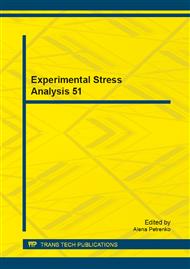p.245
p.249
p.255
p.259
p.267
p.273
p.277
p.283
p.289
Acoustic Emission Monitoring during Static Modulus Elasticity Test of Concrete Specimen
Abstract:
Acoustic emission method is often used to detect a failure at a very early stage of damage long before a structure completely fails. The paper presents experiment focused on analysing acoustic emission signals captured during commonly used static modulus elasticity test of specimens of concrete. Quantitative acoustic emission techniques were used to measure micro fracture properties. For three different concrete mixtures typical acoustic emission patterns were identified in the acoustic emission records to further describe the under-the-stress behaviour and failure development. Although we are able to predict failure loads and damage patterns to some extent, we still do not have a good understanding of the relationships between micro structural phenomena and the corresponding effects on macroscopic behaviour. It logically follows that if we have a better understanding of the relationships between micro structural events and macroscopic behaviour, we will be in a better position to formulate predictive models for large-scale structural performance and reliability. An understanding of microstructureperformance relationships is the key to true understanding of material behaviours. Since we know that material microstructure influences its properties, and that cement-based materials of different microstructure have different failure properties and then the variations in micro fracture phenomena must be manifested in the acoustic emission response of the different specimens.
Info:
Periodical:
Pages:
267-272
Citation:
Online since:
December 2013
Authors:
Price:
Сopyright:
© 2014 Trans Tech Publications Ltd. All Rights Reserved
Share:
Citation:


